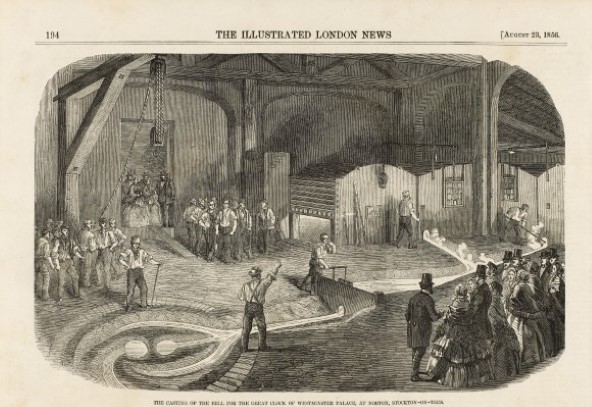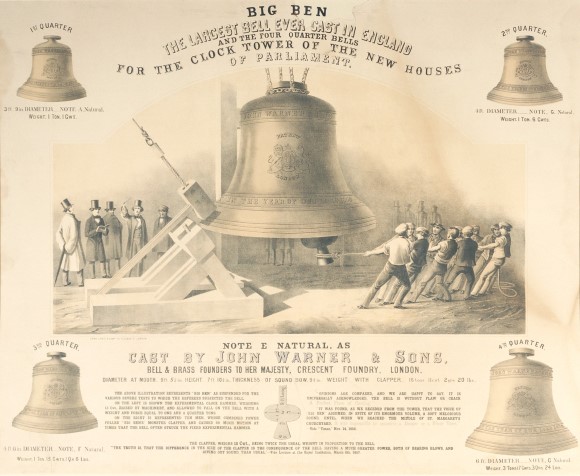Constructing the most accurate clock in the world
Charles Barry was not a specialist in clock design. He sought advice from Benjamin Lewis Vulliamy, the Queen's Clockmaker. Vulliamy began designing a clock for Barry's tower. Other respected clockmakers, like Edward John Dent, wanted to be involved and disputes broke out. In 1846 a competition was held to decide who should build the clock.
Above: Detail of the Clock Mechanism © UK Parliament
Sir George Airy, Astronomer Royal, was to referee the competition. He wanted the most accurate turret clock in the world and specified that the Great Clock for Parliament’s tower should be accurate to within one second when striking the hour.
Designing a clock capable of such accuracy was a massive challenge. Until then, time had largely been measured by the rising sun which meant that time varied by about 15 minutes across Britain. Not until February 1852 were any designs deemed good enough to build such a clock, and they were drawn up by Edmund Beckett Denison.
Denison was a lawyer and amateur horologist, so the famous chronometer and watchmaker Edward John Dent was appointed to build the clock. That same year, Queen Victoria officially opened the New Palace of Westminster at the State Opening of Parliament. The clock tower was still unfinished.
It took two years to complete the clock mechanism and it cost £2,500 (equivalent to about £285,000 today). The clock was installed in April 1859 when the building works were complete, and it successfully began keeping time on 31 May 1859.
Intricate tests were carried out to ensure its accuracy. At the Royal Observatory at Greenwich were the nation’s most accurate chronometers. A telegraph wire was used to send the time on the chronometers to the New Palace of Westminster from the Royal Observatory to check its accuracy. The Great Clock passed the test and did indeed tell the right time.
Casting the Great Bell

Above: ‘The Casting of the Bell’, Illustrated London News 1856, Monochrome wood engraving by Illustrated London News, © Parliamentary Art Collection, WOA 4661
In order for Barry’s vision of the greatest chiming turret clock in the world to succeed, he needed bells. A Great Bell was commissioned to hang in the belfry with four smaller quarter bells. Every fifteen minutes, the quarter bells would chime and every hour the Great Bell would strike to let Parliament and Londoners know the time.
John Warner’s foundry near Stockton-on-Tees cast the bell in August 1856 and the four quarter bells were also cast by his firm’s foundry at Cripplegate in London later the same year. The new hour bell was moved by rail and sea and triumphantly pulled across Westminster Bridge by 16 white horses.
Hammer was too heavy
Denison wanted the loudest sound possible so installed a huge hammer to strike the hour bell in a cradle in the yard below the tower. The bell was tested each day until 17 October 1857 when a 1.2m crack appeared. The hammer was too heavy.

Above: ‘Big Ben The Largest Bell Ever Cast in England’, Colour lithograph published by Edward Lewis & Co., © Parliamentary Art Collection, WOA 1414
The giant bell was removed and melted down to create the replacement bell which hangs in the clock tower’s belfry today. The new bell was cast by George Mears at the Whitechapel Bell Foundry on 10 April 1858. At 13.5 tonne, it was 2.5 tonne lighter than the first.
In order to get the new bell up to the belfry it had to be turned on its side. It took 30 hours to winch it up the ventilation shaft inside the tower.
Overseeing these complicated later stages of the tower was the First Commissioner of Works, Sir Benjamin Hall MP. It is believed the Great Bell, ‘Big Ben’, was probably named after him in fun - because he was a tall man.
Big Ben rang out for the first time on 11 July 1859, but the success was short-lived. In September this new bell also cracked and Big Ben was silent for four years. Until a solution was found, the largest quarter bell struck the hourly bong.
A clever solution
It was Sir George Airy, the Astronomer Royal, who eventually came up with a solution. Big Ben was turned 90 degrees so that it was struck in a different spot, and the original hammer was replaced by a lighter one. A small square was also cut out of the bell to prevent the crack from spreading. The old crack and the hole are still visible today.
The Great Bell with the smaller hammer strikes a soulful E note. It was Edmund Denison who chose the tune played on the four smaller bells, the ‘Cambridge Quarters’ from the church of Great St Mary’s in Cambridge.
